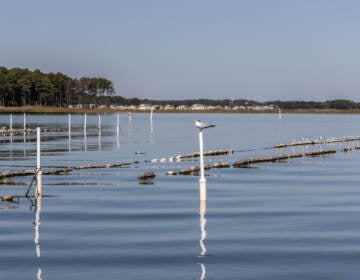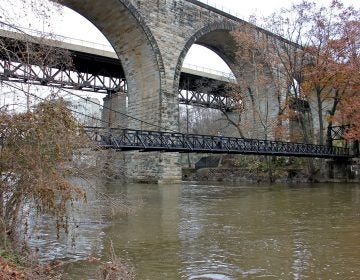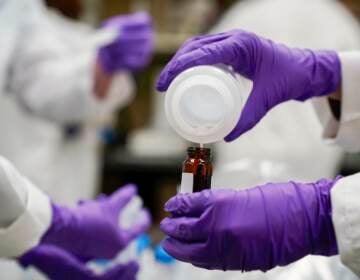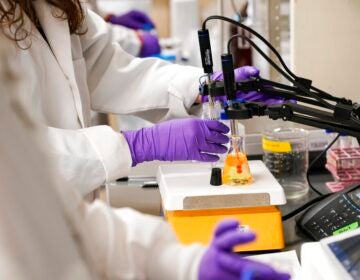The Delaware Bay’s female horseshoe crabs spared from commercial harvesting for another year
Conservationists are cheering a decision to prevent next year’s harvest of female horseshoe crabs, which will also help the threatened red knot.
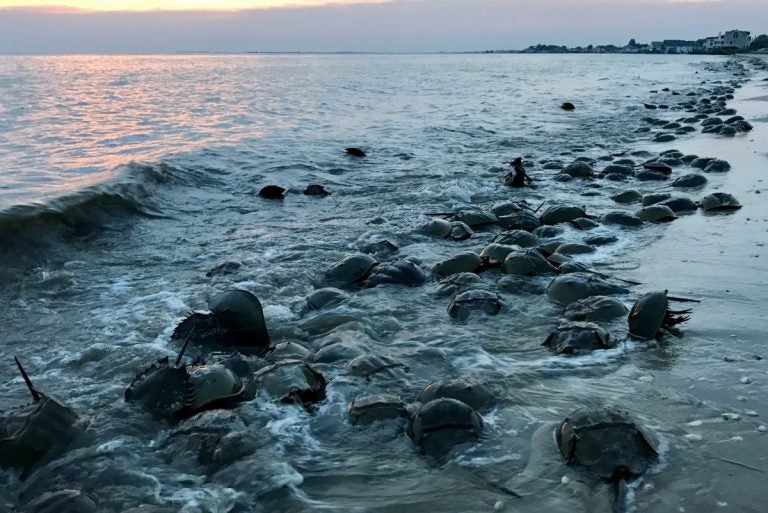
When the spring high tides strike, tens of thousands of horseshoe crabs descend on the Delaware Bay to spawn. (Steph Yin / WHYY)
Conservationists are cheering a decision to prevent the commercial harvesting of female horseshoe crabs next year — a move that will help the red knot, a migratory bird listed as threatened by the U.S. Fish and Wildlife Service.
Red knots travel 9,000 miles each year from South America to the Arctic, making a stop at the Delaware Bay to rest and refuel on the crab’s eggs.
This week, the Atlantic States Marine Fisheries Commission, which coordinates the conservation and management of fish species on the Atlantic Coast, voted to continue a decade-old practice of permitting a male-only commercial harvest for 2023.
The regulators cited an influential public comment process, which included more than 34,000 letters in support of the crabs and the red knots.
“The bay states got together and had a discussion about whether or not we felt comfortable harvesting female horseshoe crabs in lieu of all the comments we received, and we came to this decision together,” said board member Shanna Madsen.
In January, the ASMFC approved a measure that could have led to a female harvest in 2023. Females have been protected for the past 10 years, because of the importance of their eggs. Environmentalists feared adding female horseshoe crabs to next year’s harvest would imperil the shorebirds.
“The public spoke resoundingly in favor of protecting this ecosystem and the incredible relationship between horseshoe crabs and red knots. And the commission appropriately acknowledged how important the horseshoe crabs are to the public,” said Ben Levitan, an attorney with the environmental law firm Earthjustice.

The shared fate of red knots and horseshoe crabs
Red knots declined about 75% from the 1980s to the 2000s, the U.S. Fish & Wildlife Service reports, largely because of reduced horseshoe crab eggs. Horseshoe crabs, which are used as bait to catch eel and whelk, reached devastating lows in the 1990s because of overharvesting. Though harvesting restrictions have improved horseshoe crab populations, red knot numbers remain critically low, according to some surveys.
Since 2012, the ASMFC has recommended a male-only horseshoe crab harvest, using a scientific model (known as the ARM Framework) to calculate the amount of horseshoe crabs that can be harvested while still protecting red knots.
In January, the commission advanced a move to adopt a new framework for calculating quotas that utilizes data suggesting female harvests can be achieved while maintaining red knot health. The decision provoked public outcry.
On Thursday, ASMFC voted to implement the new framework, arguing it provides the most up-to-date science. The move then gave the commission the option to recommend a maximum harvest of 125,000 females across Delaware, New Jersey, Maryland and Virginia. But citing public comment, the commission voted to implement a male-only harvest for 2023, saying it did not have to follow all aspects of the new framework.
“We can accept the best available science for management, and make [our own] decisions regarding what we’re going to do with the harvest after that point,” said board member Madsen, who also is the deputy chief of the Virginia Marine Resources Commission.
The commission recommends that no more than 475,000 male crabs across the four states be commercially harvested next year. Because Maryland and Virginia share a smaller quota than the states to the north, they can offset the female moratorium by harvesting more males. That means the actual maximum of males will be closer to 550,000.
New Jersey has already implemented a statewide ban, and does not allow commercial harvesting of any sex.
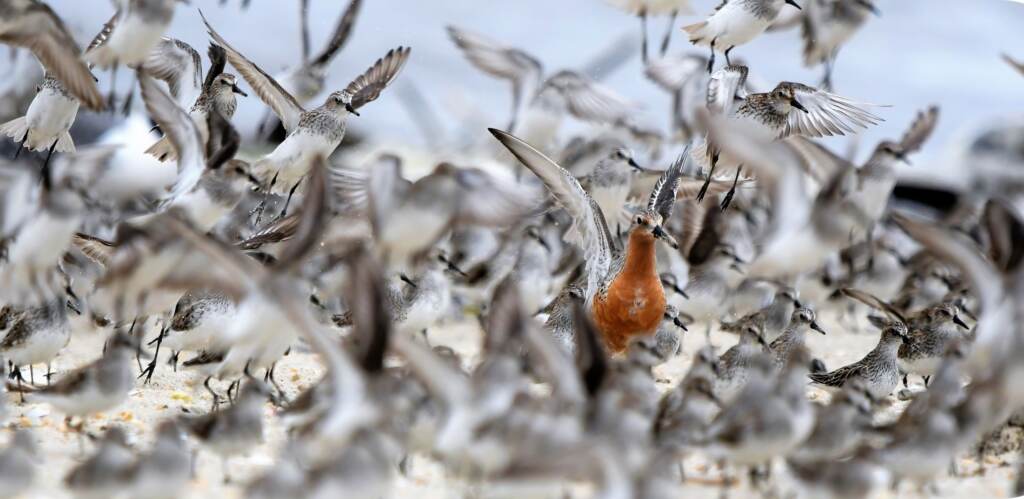
(Courtesy of Chris Neff/New Jersey Audubon)
The fight for horseshoe crab protections continues
Though the ASMFC’s division is a win for environmentalists, they say more advocacy is needed. Steve Cottrell of the Delaware Audubon Society is calling for a complete moratorium on harvesting. His organization has called upon Delaware legislators to follow New Jersey and introduce legislation to ban commercial harvesting of any sex.
They’re also concerned about the harvesting of horseshoe crabs for biomedical research. The crab’s bright blue blood contains a compound used by medical researchers to test the sterility of injectable drugs, biomedical devices, and vaccines. Their blood also aided in the development of the COVID-19 vaccine.
Though horseshoe crabs are returned to the water after being bled by lab technicians, it is believed 15 to 30% eventually die. The ASMFC estimates that 697,025 horseshoe crabs were harvested for biomedical purposes in 2021, representing a 3% increase from 2020. Scientists don’t know the overall impact of bleeding horseshoe crabs, because the data is self-reported. The ASMFC does not set quotas for harvesting for biomedical purposes. Some states, like Delaware, do not allow biomedical harvests, but New Jersey permits the practice.
The Delaware Audubon Society’s Cottrell supports the use of man-made horseshoe crab blood, which has been developed as an alternative for harvesting horseshoe crabs for biomedical purposes. However, its use has not been considered in the U.S.
“One of the goals of environmental groups moving forward is to try to put pressure on these groups that are resisting the conversion,” he said. “There’s going to be a battle, because this industry is well-financed. They have lobbyists who are influential.”
A much debated change to calculating horseshoe crab harvests
Larry Niles, a biologist formerly with New Jersey’s Fish and Wildlife division, said he’s pleased females won’t be included in next year’s commercial harvest. However, he opposes the commission’s decision to adopt the new framework. Niles and other opponents believe it uses data points that don’t paint a full picture of horseshoe crab health, and overestimates populations of crabs and red knots.
ASMFC reports that Delaware Bay horseshoe crab populations have steadily increased to 21.9 million males and 9.4 million females. However, Niles argues that egg density is a more important figure. He and his colleagues at the Delaware Bay Shorebird Project found that horseshoe crab egg density in the Delaware Bay was about 7,000 eggs per square meter in May 2022. By comparison, eggs reached nearly 50,000 per square meter in the 1990s.
“Egg densities have not improved since the time that this agency started managing crabs,” Niles said, adding that “there’s as many crabs dying as are coming into the population.”
The Project reports red knots remained at historically low levels in 2022. Though numbers increased from 6,800 in 2021 to more than 12,000 this year, it’s less than half the 2019 peak count of 30,000 — and a fraction of the peak population of more than 94,000 in 1989. The U.S. Geological Survey estimates that 40,000 to 50,000 red knots stop and feed each spring along the Delaware Bay.
But Niles argues that the survey is flawed. He says that’s an overcount because it includes birds flying overhead that are looking for food that they may never find — rather than solely birds that stop on the shore to eat and successfully make their way to the Arctic to breed.
Proponents of the new framework say it’s more accurate than the previous one, partly because it’s based on empirical data collected directly from the Delaware Bay. In the previous framework, much information used to formulate the population model for horseshoe crabs was from Pleasant Bay, Mass., because Delaware Bay information wasn’t available.
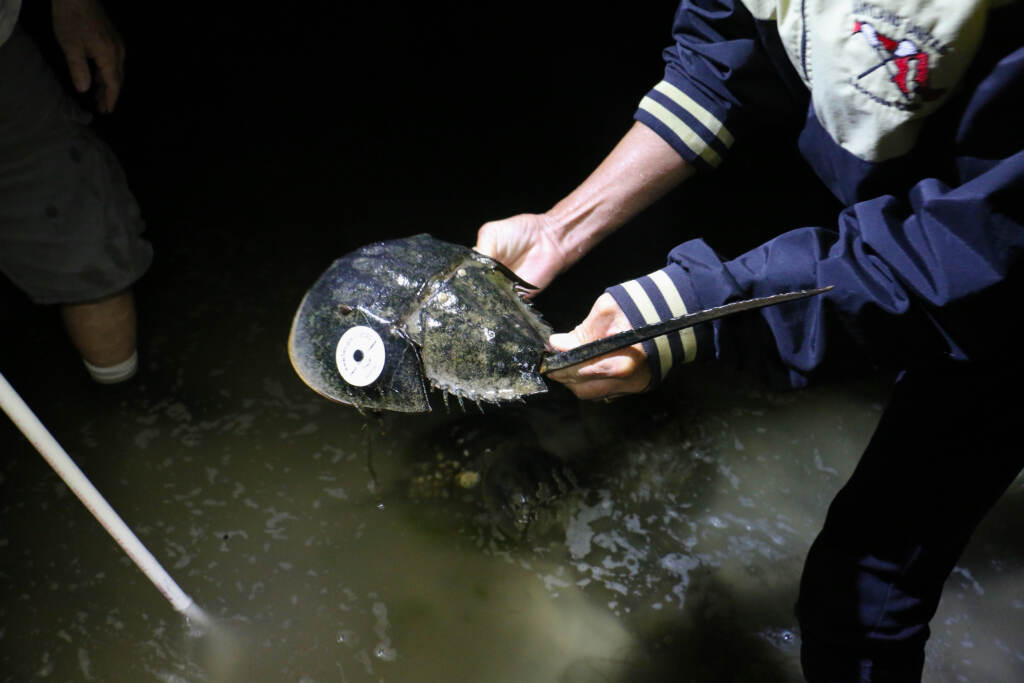
The new framework also includes new mortality data, including horseshoe crabs that die after being bled and released for biomedical purposes, and deaths caused by catch in other fisheries. That offers a better estimate of the number of crabs in the population, proponents argue.
Another concern about the former framework is that if horseshoe crab and red knot populations reached a certain threshold, the harvesting quota for females would automatically jump from zero to 210,000. Under the new method, quotas will increase gradually if female horseshoe crab abundance continues to increase.
The U.S. Fish and Wildlife Service has endorsed the model, arguing that it utilizes the most advanced data.
“It does reflect the best available science available to us today,” said Rick Jacobson, the Service’s assistant regional director for fish and aquatic conservation, following Thursday’s vote.
However, he added that in order to gain the public’s confidence, it’s important for the ASMFC to provide more transparency.
“We are gratified that the commission opted to forestall the harvest of female horseshoe crabs … by forestalling a female horseshoe crab harvest for 2023, it will give the public additional opportunity to explore that model to develop a greater confidence in it,” Jacobson said.

Get daily updates from WHYY News!
WHYY is your source for fact-based, in-depth journalism and information. As a nonprofit organization, we rely on financial support from readers like you. Please give today.



